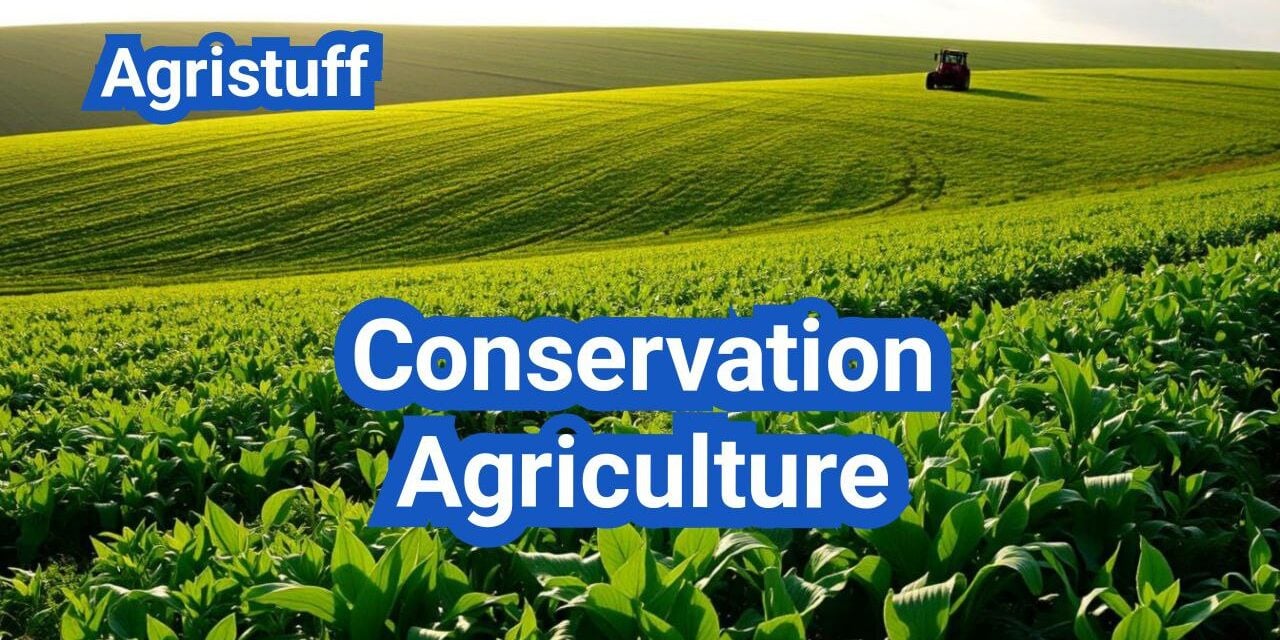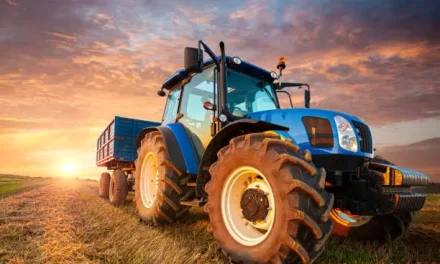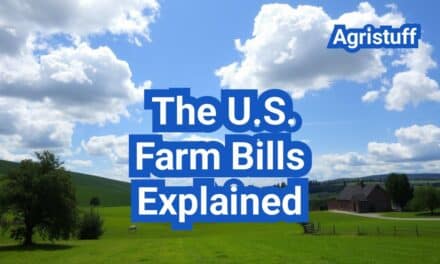Conservation agriculture is an approach to farming that minimizes soil disturbance, maintains permanent soil cover, and diversifies crop rotations.
This method promotes sustainable agriculture by enhancing soil health, reducing erosion, and improving water retention.
The core principles of this approach include minimizing soil disturbance through no-till or reduced tillage methods, maintaining cover crops to protect the soil, and rotating crops to promote soil fertility and structure.
By adopting these practices, farmers can improve the overall sustainability of their farming operations.
Key Takeaways
- Conservation agriculture minimizes soil disturbance and promotes soil health.
- No-till and reduced tillage methods reduce soil erosion.
- Cover crops protect the soil and improve water retention.
- Diversifying crop rotations enhances soil fertility and structure.
- Sustainable agriculture practices improve overall farming sustainability.
What Is Conservation Agriculture?
Conservation agriculture represents a significant shift in agricultural practices, emphasizing minimal soil disturbance, permanent soil cover, and crop rotations. This approach is gaining recognition for its potential to enhance soil health, reduce erosion, and promote sustainable farming practices.
Definition and Core Principles
Conservation agriculture is defined by its three main principles: minimal soil disturbance, permanent soil cover, and crop rotation. Minimal soil disturbance involves reducing or eliminating tillage, which helps preserve soil organic matter and reduce erosion. Permanent soil cover ensures that the soil is always covered with organic matter, such as crop residues or cover crops, protecting it from erosion and improving soil health. Crop rotation and diversification are crucial for maintaining soil fertility, reducing pests and diseases, and promoting ecological balance.
Historical Development in the United States
The concept of conservation agriculture has evolved over time in the United States. Initially, it was driven by the need to reduce soil erosion during the Dust Bowl era in the 1930s. Over the years, the approach has been refined and expanded to include a broader range of practices aimed at promoting soil health and sustainability.
Current Adoption Rates and Trends
Conservation agriculture is being increasingly adopted in the United States, with various forms of conservation tillage and cover cropping being used across different regions. According to recent data, the adoption rates vary by region and crop type.
| Region | Adoption Rate of Conservation Tillage (%) | Adoption Rate of Cover Cropping (%) |
|---|---|---|
| Midwest | 45 | 30 |
| Southern States | 35 | 25 |
| Western States | 20 | 15 |
The trend towards conservation agriculture is driven by its potential to improve soil health, reduce environmental impact, and enhance farm profitability. As more farmers adopt these practices, the agricultural industry is likely to see significant changes in the coming years.
The Three Pillars of Conservation Agriculture

Conservation agriculture is built around three critical components that not only support soil health but also contribute to a more resilient farming system. These pillars are crucial for the success of conservation agriculture, contributing to improved soil health, biodiversity, and efficient water use.
Minimal Soil Disturbance
Minimal soil disturbance is a cornerstone of conservation agriculture. It involves reducing or eliminating tillage, which can damage soil structure, disrupt soil biota, and lead to erosion. By minimizing soil disturbance, farmers can preserve soil organic matter, reduce soil compaction, and promote soil biota. As stated by the Food and Agriculture Organization (FAO), “Reducing tillage intensity is key to maintaining soil health and reducing the environmental footprint of agriculture.”
Permanent Soil Cover
Permanent soil cover is another vital pillar, achieved by maintaining a cover of crops, residues, or other materials on the soil surface. This cover protects the soil from erosion, improves soil health, and supports biodiversity. It also helps in regulating soil temperature and retaining moisture. According to a study on conservation agriculture, “Maintaining a permanent soil cover is essential for reducing soil erosion and improving water infiltration.”
Crop Rotation and Diversification
Crop rotation and diversification are essential for a resilient farming system. Rotating crops helps in breaking disease and pest cycles, improving soil fertility, and increasing biodiversity. It also allows farmers to diversify their production, potentially improving their economic resilience. As noted by conservation agriculture experts, “Crop rotation is a powerful tool for maintaining soil health and controlling pests and diseases without relying heavily on chemicals.”
By implementing these three pillars—minimal soil disturbance, permanent soil cover, and crop rotation and diversification—farmers can significantly enhance the sustainability of their farming practices. These practices not only improve soil health and biodiversity but also contribute to more efficient water use and reduced environmental impact.
“Conservation agriculture is not just a set of practices; it’s a holistic approach to farming that requires a deep understanding of the interactions between soil, plants, and the environment.”
Assessing Your Farm’s Readiness for Conservation Practices
To successfully implement conservation agriculture, farmers must first evaluate their farm’s readiness. This assessment involves examining various factors that influence the adoption and success of conservation practices.
Evaluating Current Soil Conditions
A thorough soil assessment is critical in determining your farm’s readiness for conservation agriculture. This involves evaluating soil health indicators such as organic matter content, soil structure, and biodiversity.
Soil health assessment can be conducted through various methods, including:
- Soil testing for nutrient levels and pH
- Visual examination of soil structure and aggregation
- Assessment of soil biota and microbial activity
| Soil Health Indicator | Description | Importance |
|---|---|---|
| Organic Matter Content | Percentage of soil composed of organic materials | Improves soil structure, increases water retention |
| Soil Structure | Arrangement of soil particles | Affects water infiltration, aeration, and root growth |
| Biodiversity | Variety of organisms living in the soil | Enhances ecosystem services, nutrient cycling |
Climate and Regional Considerations
Climate and regional factors significantly impact the suitability of conservation practices for your farm. Understanding these factors is essential for making informed decisions.
Climate considerations include:
- Average annual rainfall and its distribution
- Temperature fluctuations and extreme weather events
- Regional pest and disease pressures
Equipment and Resource Assessment
Assessing your farm’s equipment and resources is vital for the successful implementation of conservation practices. This includes evaluating the availability and suitability of machinery, as well as financial and labor resources.
Equipment considerations may involve:
- No-till planters or drills
- Cover crop seeding equipment
- Residue management tools
By carefully assessing your farm’s readiness, you can make informed decisions about adopting conservation agriculture practices that are tailored to your specific conditions and needs.
No-Till Farming: When It Works Best

Understanding the right conditions for no-till farming is crucial for maximizing its benefits in conservation agriculture. No-till farming is particularly beneficial for certain soil types and crop systems, and requires specific planter setups.
Ideal Soil Types and Conditions
No-till farming works best in soils that are well-drained and have a moderate to high organic matter content. Soils with heavy clay or sandy textures can be challenging for no-till, as they may require special management to avoid compaction and ensure adequate seed-to-soil contact.
Soil condition is also a critical factor. No-till is more effective in soils that are not prone to waterlogging and have a relatively level terrain, reducing the risk of erosion.
Crop Systems Most Suitable for No-Till
Crop selection is vital for the success of no-till farming. Crops that are tolerant of or benefit from the residue cover on the soil surface are ideal. Corn and soybean rotations are commonly used in no-till systems due to their adaptability and the economic benefits they provide.
No-till is also suitable for small grains and certain cover crops that can be effectively managed with no-till planters.
No-Till Planter Setup and Calibration
The success of no-till farming heavily relies on the proper setup and calibration of no-till planters. Adjusting the planter to handle varying levels of residue and ensuring accurate seed placement are critical for achieving uniform emergence and maximizing yields.
Calibration involves checking and adjusting the planter’s components, such as row cleaners, coulters, and seed meters, to ensure they are functioning correctly for the specific soil and crop conditions.
By understanding and implementing these key aspects, farmers can optimize their no-till farming practices, leading to improved soil health, reduced erosion, and potentially higher crop yields.
Cover Crops: Selecting the Right Species for Your Goals
The effectiveness of cover crops in conservation agriculture depends on selecting species that align with your farming goals, whether it’s improving soil structure or suppressing weeds. Different cover crop species offer various benefits, such as weed suppression, nitrogen fixation, and biodiversity enhancement.
Cereal Rye for Weed Suppression and Biomass
Cereal rye is a popular cover crop choice due to its ability to suppress weeds and produce significant biomass. It is particularly effective in no-till systems, where it can help reduce weed pressure and improve soil health.
Benefits of Cereal Rye:
- Effective weed suppression
- High biomass production
- Improved soil health
Legume Cover Crops for Nitrogen Fixation
Legume cover crops, such as clover and hairy vetch, are valued for their nitrogen-fixing capabilities. They can significantly reduce the need for synthetic nitrogen fertilizers, improving soil fertility and reducing environmental impact.
Nitrogen Fixation Benefits:
- Reduced need for synthetic fertilizers
- Improved soil fertility
- Enhanced biodiversity
Multi-Species Mixes and Their Benefits
Planting multi-species mixes of cover crops can offer a range of benefits, including improved soil health, increased biodiversity, and enhanced ecosystem services. These mixes can be tailored to specific farming goals and conditions.
| Cover Crop Mix | Benefits |
|---|---|
| Cereal Rye + Legumes | Weed suppression, nitrogen fixation, improved soil health |
| Brassicas + Grasses | Biodiversity enhancement, soil structure improvement |
| Multi-species mixes | Enhanced ecosystem services, improved resilience |
By carefully selecting the right cover crop species or mixes, farmers can achieve their conservation agriculture goals, improving soil health, reducing environmental impact, and enhancing overall farm productivity.
Reduced Tillage Systems: Finding the Right Balance

In the quest for sustainable agricultural practices, reduced tillage systems offer a promising middle ground between conventional tillage and no-till farming. These systems aim to minimize soil disturbance while maintaining adequate soil cover, thereby addressing some of the challenges associated with both no-till and conventional tillage.
Strip-Till vs. No-Till: Comparative Analysis
Strip-till and no-till are two conservation tillage practices that have gained popularity for their potential to reduce soil erosion and improve soil health. Strip-till involves tilling narrow strips where seeds are planted, leaving the inter-row areas untilled, whereas no-till farming avoids tillage altogether. A comparative analysis of these two methods reveals that strip-till can offer advantages in certain soil types and climates, particularly where improved soil warming and better seedbed preparation are needed.
“Strip-till can be particularly beneficial in cooler climates or soils with poor drainage,” notes a leading agricultural researcher. “By tilling narrow strips, farmers can improve soil temperature and moisture conditions, potentially leading to earlier planting and better crop establishment.”
When Strip-Till Offers Advantages
Strip-till offers several advantages over no-till in specific situations. For instance, in fields with heavy residue or where soil compaction is a concern, strip-till can help manage residue and improve soil conditions for the subsequent crop. Additionally, strip-till can be more effective in managing soil nutrients, as it allows for banded fertilizer application directly in the tilled strip.
- Improved soil warming
- Better seedbed preparation
- Enhanced nutrient management
Transitioning from Conventional to Reduced Tillage
Transitioning from conventional tillage to reduced tillage systems requires careful planning and management. Farmers should start by assessing their soil’s current condition and identifying potential challenges, such as heavy residue or soil compaction. Gradual reduction in tillage intensity, along with the adoption of conservation practices like cover cropping, can help mitigate these challenges and ensure a smoother transition.
As one agricultural expert advises, “The key to successful reduced tillage is patience and persistence. It may take a few seasons to see the full benefits, but with proper management, the payoff can be significant in terms of both environmental sustainability and economic viability.”
Soil Health Assessment in Conservation Systems
Effective conservation agriculture begins with a comprehensive assessment of soil health. Soil health assessment is crucial for understanding the physical, chemical, and biological properties of the soil, which in turn informs management decisions to improve or maintain soil productivity and sustainability.
Infiltration and Slake Tests
Two important methods for assessing soil health are infiltration tests and slake tests. Infiltration tests measure the rate at which water enters the soil, indicating the soil’s ability to absorb and retain water. This is crucial for reducing runoff and erosion. Slake tests, on the other hand, evaluate the stability of soil aggregates when exposed to water, providing insights into the soil’s structural integrity.
Infiltration tests can be performed using simple tools like a single-ring infiltrometer or more complex setups. The results help farmers understand the soil’s water-holding capacity and potential for waterlogging or drought susceptibility.
Measuring Soil Aggregate Stability
Soil aggregate stability is a key indicator of soil health, reflecting the soil’s resistance to erosion and its ability to support plant growth. Soil aggregates are groups of soil particles that bind together, and their stability is influenced by factors such as organic matter content, microbial activity, and tillage practices.
Measuring soil aggregate stability involves wet sieving or using a rainfall simulator to assess how well the soil aggregates withstand water exposure. High aggregate stability indicates good soil structure, which is essential for healthy root development and water infiltration.
Biological Indicators of Soil Health
Biological indicators, such as microbial activity, earthworm populations, and soil respiration, provide valuable insights into the soil’s ecosystem. These indicators reflect the soil’s capacity to support biodiversity and nutrient cycling.
- Microbial activity can be assessed through tests like the soil respiration test, which measures the CO2 produced by microorganisms.
- Earthworm counts are a direct indicator of soil health, as earthworms improve soil structure and fertility.
- Soil enzyme assays can also be used to evaluate microbial activity and nutrient cycling potential.
By combining these physical, chemical, and biological assessments, farmers can gain a comprehensive understanding of their soil’s health and make informed decisions to enhance conservation agriculture practices.
Managing Residue Effectively

Managing crop residue is a critical aspect of conservation agriculture, directly impacting soil health and erosion control. Effective residue management involves a combination of strategies tailored to specific cropping systems and soil types.
Residue Management in Corn-on-Corn Rotations
Corn-on-corn rotations present unique challenges for residue management due to the high volume of residue produced. High residue levels can lead to soil cooling, increased disease pressure, and challenges with planting and seed establishment. To manage residue effectively in these systems, farmers can employ several strategies:
- Chopping corn stalks to improve residue distribution and accelerate decomposition.
- Using residue spreaders on combines to ensure even distribution of residue across the field.
- Implementing cover crops to help manage excess residue and improve soil health.
As noted by a study on conservation agriculture, “Managing residue is not just about getting rid of it; it’s about using it to your advantage to improve soil health and reduce erosion”
This approach not only aids in residue management but also contributes to overall soil health and productivity.
Balancing Residue Decomposition and Soil Protection
Achieving a balance between residue decomposition and soil protection is crucial. Residue decomposition contributes to nutrient cycling and soil organic matter, while excessive residue can interfere with planting and crop establishment. Strategies to balance these factors include:
| Strategy | Benefits |
|---|---|
| Using cover crops | Enhances soil protection, improves soil health, and aids in residue decomposition. |
| Adjusting tillage practices | Helps manage residue levels and improves soil aeration. |
| Monitoring residue levels | Ensures that residue does not accumulate to levels that interfere with crop establishment. |
By adopting these strategies, farmers can maintain the benefits of residue while minimizing its drawbacks.
Equipment Adjustments for Heavy Residue
Managing heavy residue often requires adjustments to farming equipment. Planters and drills may need to be equipped with residue-cutting coulter or other specialized components to handle heavy residue conditions. Additionally, combine harvesters can be fitted with spreader systems to distribute residue evenly across the field.
Effective residue management is a multifaceted approach that involves the right combination of practices, equipment, and planning. By understanding the challenges and opportunities presented by residue, farmers can improve soil health, reduce erosion, and enhance overall farm productivity.
Cover Crop Management Strategies

Cover crop management involves a combination of proper planting techniques, timely termination, and integration with cash crops. Effective management is crucial for maximizing the benefits of cover crops, such as improved soil health, reduced erosion, and enhanced biodiversity.
Planting Methods and Timing
The success of cover crops begins with appropriate planting methods and timing. Farmers can choose from various planting techniques, including drilling, broadcasting, or aerial seeding, depending on the specific conditions of their fields and the type of cover crop being used.
Table: Common Cover Crop Planting Methods
| Planting Method | Description | Best For |
|---|---|---|
| Drilling | Precise seed placement at uniform depth | Small grains, legumes |
| Broadcasting | Spreading seeds across the surface | Large areas, mixed species |
| Aerial Seeding | Seeds dispersed by aircraft or drone | Large fields, hard-to-reach areas |
Termination Techniques Including Roller-Crimper
Termination is a critical step in cover crop management, as it ensures that the cover crop does not compete with the subsequent cash crop for water, nutrients, and light. One effective termination technique is the use of a roller-crimper, which crushes the cover crop, leaving it on the surface as a mulch layer.
The roller-crimper is particularly useful for terminating cereal rye and other grasses. It allows for a chemical-free termination method, reducing the environmental impact and cost associated with herbicides.
Integrating Cover Crops with Cash Crops
Integrating cover crops into cash crop rotations requires careful planning to ensure that the cover crops complement the cash crops rather than competing with them. This involves selecting cover crop species that are compatible with the cash crops and managing them in a way that enhances soil health and overall farm productivity.
For example, planting a legume cover crop before a corn crop can provide nitrogen fixation, reducing the need for synthetic fertilizers. Similarly, using a grass cover crop after a soybean crop can help to reduce erosion and improve soil structure.
By adopting these cover crop management strategies, farmers can improve the sustainability and productivity of their farming operations, contributing to a more resilient agricultural system.
Nutrient Management in Conservation Agriculture

Optimizing nutrient management is essential for conservation agriculture to improve crop yields and reduce environmental impact. Nutrient management involves a combination of strategies to ensure that crops receive the necessary nutrients for optimal growth while minimizing waste and environmental degradation.
Banded P & K Applications in Strip-Till
Banded phosphorus (P) and potassium (K) applications are a common practice in strip-till systems. This method involves applying fertilizers in bands along the strip where the crop will be planted, rather than broadcasting them over the entire field. Banded applications can improve nutrient use efficiency by placing nutrients in closer proximity to the roots, thus enhancing uptake.
The benefits of banded P & K applications include:
- Improved nutrient use efficiency
- Enhanced crop growth and yields
- Reduced nutrient loss through leaching or runoff
Nitrogen Management with Cover Crops
Cover crops play a significant role in nitrogen management within conservation agriculture. Legume cover crops, for example, can fix atmospheric nitrogen, making it available to subsequent crops. Effective nitrogen management with cover crops involves selecting the right species and managing them appropriately to maximize nitrogen benefits.
| Cover Crop Type | Nitrogen Contribution | Other Benefits |
|---|---|---|
| Legumes (e.g., clover, beans) | High nitrogen fixation | Soil health improvement, weed suppression |
| Grasses (e.g., rye, oats) | Low to moderate nitrogen immobilization | Erosion control, soil structure improvement |
| Brassicas (e.g., radish, turnip) | Variable nitrogen uptake | Soil compaction alleviation, pest control |
Soil Testing and Fertility Planning
Regular soil testing is critical for fertility planning in conservation agriculture. Soil tests provide valuable information on nutrient levels, pH, and other factors that influence soil fertility. Fertility planning based on soil test results enables farmers to make informed decisions about nutrient applications, ensuring that crops receive the necessary nutrients while minimizing the risk of over-fertilization.
By integrating banded P & K applications, nitrogen management with cover crops, and soil testing for fertility planning, farmers can optimize nutrient management in conservation agriculture. This holistic approach not only enhances crop productivity but also contributes to sustainable farming practices.
Overcoming Weed Management Challenges

Weed management poses significant challenges in conservation agriculture, requiring integrated strategies. Effective weed control is crucial for maintaining soil health, ensuring crop productivity, and supporting the overall sustainability of conservation agriculture practices.
Integrated Weed Management (IWM) Strategies
Integrated Weed Management involves a combination of techniques to manage weeds, including cultural, mechanical, and chemical controls. Cultural controls involve practices like crop rotation and cover cropping, which can suppress weed growth. Mechanical controls include methods such as hand weeding and mechanical weeding. Chemical controls involve the judicious use of herbicides.
A successful IWM strategy starts with understanding the weed species present in your field and their life cycles. This knowledge helps in selecting the most appropriate control methods. For instance, using cover crops that compete with weeds for resources can significantly reduce weed pressure.
| IWM Strategy | Description | Benefits |
|---|---|---|
| Crop Rotation | Alternating crops to disrupt weed life cycles | Reduces weed pressure, improves soil health |
| Cover Cropping | Planting crops between cash crops to compete with weeds | Suppresses weeds, enhances soil health |
| Mechanical Weeding | Using machinery to remove weeds | Effective for controlling weeds, reduces herbicide use |
Herbicide Considerations with Cover Crops
When using cover crops, it’s essential to consider the implications for herbicide use. Some cover crops can be sensitive to herbicides, and their use may require adjustments to herbicide application timing or selection. Additionally, cover crops can affect the efficacy of herbicides by altering soil moisture and temperature.
Herbicide selection should be based on the type of cover crop and the weeds being targeted. It’s also crucial to follow label instructions and take necessary precautions to avoid damage to the cover crop or subsequent cash crop.
Managing Herbicide Carryover
Herbicide carryover occurs when herbicides persist in the soil and affect subsequent crops. This can be a significant issue in conservation agriculture, where crop rotations and cover cropping are common. Managing herbicide carryover involves understanding the persistence of herbicides in the soil and planning crop rotations accordingly.
Factors influencing herbicide carryover include soil type, organic matter content, and microbial activity. For example, herbicides tend to persist longer in soils with high clay content or low microbial activity. Understanding these factors can help in making informed decisions about herbicide use and crop rotation planning.
Building Drought Resilience Through Conservation Agriculture

As droughts become more frequent, adopting conservation agriculture practices can significantly improve a farm’s ability to withstand them. Conservation agriculture is centered around three main principles: minimal soil disturbance, permanent soil cover, and crop rotation. These practices not only enhance soil health but also contribute to improved drought resilience.
Improving Water Infiltration and Retention
One of the key benefits of conservation agriculture is its ability to improve soil’s water infiltration and retention. By minimizing soil disturbance and maintaining soil cover, farmers can enhance the soil’s structure, allowing it to absorb and retain more water. This is crucial during droughts when water availability is limited.
- Reduced soil compaction allows for better water infiltration.
- Permanent soil cover protects the soil from erosion and retains moisture.
- Crop rotation and diversification improve soil’s water-holding capacity.
Drought Resilience Practices
Adopting specific drought resilience practices within conservation agriculture can further enhance a farm’s ability to cope with drought. These include:
- Using drought-tolerant crop varieties.
- Implementing efficient irrigation management systems.
- Maintaining a diverse crop rotation to spread risk.
By integrating these practices, farmers can build a more resilient agricultural system.
Reducing Runoff and Erosion
Conservation agriculture also plays a critical role in reducing runoff and erosion, which are exacerbated by drought conditions. By keeping the soil covered and minimizing disturbance, farmers can significantly reduce the risk of soil erosion.
“Conservation agriculture is not just about reducing tillage; it’s about creating a holistic farming system that works with nature to improve resilience and productivity.” –
Expert in Conservation Agriculture
Reducing runoff not only protects the soil but also helps in recharging groundwater, which is vital during droughts.
Economic Analysis of Conservation Practices

Understanding the economic implications of conservation practices is essential for farmers considering a shift from traditional farming methods. While conservation agriculture offers numerous environmental benefits, its economic viability is a crucial factor in its adoption.
Initial Investment and Long-term Returns
Adopting conservation practices often requires an initial investment in new equipment, such as no-till planters or cover crop seeders. However, these costs can be offset by long-term savings in fuel, labor, and equipment maintenance. For instance, a study on no-till farming revealed that farmers could save up to $30 per acre annually on fuel and labor costs.
The long-term returns on conservation practices can be substantial. Improved soil health can lead to increased crop yields over time, enhancing overall farm productivity. Additionally, conservation practices can provide access to new markets and premium prices for crops produced using sustainable methods.
Reduced Tillage Economics
Reduced tillage systems, including no-till and strip-till, offer significant economic benefits. By minimizing soil disturbance, these practices reduce the need for tillage passes, thereby saving on fuel, labor, and equipment wear. A comparative analysis of tillage systems is presented in the table below:
| Tillage System | Fuel Consumption (gal/acre) | Labor Hours (hours/acre) | Equipment Costs ($/acre) |
|---|---|---|---|
| Conventional Tillage | 5.2 | 2.5 | 35 |
| No-Till | 1.8 | 1.2 | 20 |
| Strip-Till | 2.5 | 1.8 | 25 |
USDA Conservation Programs and Incentives
The USDA offers various conservation programs and incentives to support farmers in adopting conservation practices. Programs such as the Conservation Stewardship Program (CSP) and the Environmental Quality Incentives Program (EQIP) provide financial assistance and technical support for implementing conservation agriculture practices.
Farmers can benefit from these programs by receiving payments for adopting conservation practices, such as cover cropping and reduced tillage. Additionally, participating in these programs can enhance a farm’s environmental stewardship and potentially increase its market value.
Implementing Conservation Agriculture: A Step-by-Step Approach
To successfully adopt conservation agriculture, farmers must follow a structured implementation plan. This involves several key steps that help ensure a smooth transition to more sustainable farming practices.
NRCS Conservation Planning Steps
The Natural Resources Conservation Service (NRCS) provides a comprehensive framework for conservation planning. The process begins with an assessment of the farm’s current conditions and identifying areas for improvement.
- Inventory and analyze the farm’s resources, including soil, water, and vegetation.
- Set clear conservation objectives based on the farm’s specific needs and goals.
- Develop a detailed conservation plan that outlines the necessary practices and activities.
- Implement the plan, starting with the most critical conservation practices.
- Monitor and evaluate the effectiveness of the conservation plan over time.
Conservation planning is an ongoing process that requires continuous monitoring and adaptation. By following these steps, farmers can develop a tailored plan that meets their unique needs and goals.
Creating a Transition Timeline
Transitioning to conservation agriculture requires a well-planned timeline. This involves:
- Assessing the current state of the farm and identifying areas for improvement.
- Setting realistic goals and milestones for the transition process.
- Developing a phased implementation plan that addresses the most critical conservation practices first.
- Establishing a monitoring and evaluation system to track progress and make adjustments as needed.
A gradual transition is often more effective than attempting to implement all changes at once. By creating a transition timeline, farmers can ensure a smooth and successful adoption of conservation agriculture practices.
Equipment Modifications and Investments
The adoption of conservation agriculture often requires modifications to existing equipment or investments in new machinery. This may include:
| Equipment | Modification/Investment | Benefit |
|---|---|---|
| No-till planter | Adjustments for optimal seed placement and soil contact | Improved crop establishment and reduced soil disturbance |
| Cover crop seeder | Investment in a dedicated cover crop seeder | Enhanced cover crop establishment and biomass production |
| Residue management equipment | Modifications for effective residue handling | Reduced soil erosion and improved soil health |
By understanding the necessary equipment modifications and investments, farmers can better plan their transition to conservation agriculture and ensure the long-term success of their conservation practices.
Designing Effective Crop Rotations
Designing a crop rotation plan that incorporates diversity and resilience is key to successful conservation agriculture practices. Effective crop rotations can improve soil health, reduce pests and diseases, and increase biodiversity.
Crop Rotation Diversity Benefits
Diverse crop rotations offer numerous benefits, including improved soil structure, increased soil organic matter, and enhanced nutrient cycling. By rotating crops, farmers can break disease and pest cycles, reducing the need for chemical interventions.
Crop rotation diversity also promotes ecological balance, supporting a wider range of beneficial insects and microorganisms. This diversity can lead to more resilient farming systems, better equipped to withstand weather extremes and market fluctuations.
Integrating Cash and Cover Crops
Integrating cash crops with cover crops is a strategic approach to enhancing crop rotation diversity. Cover crops can provide ground cover, reduce erosion, and add organic matter, while cash crops generate income.
Farmers can select cover crops that complement their cash crops, improving soil health and potentially reducing the need for fertilizers and pesticides. For example, legume cover crops can fix nitrogen, benefiting subsequent crops.
Incorporating Livestock in Conservation Systems
Incorporating livestock into conservation agriculture systems can further enhance the benefits of crop rotation. Livestock can graze on cover crops, adding value to the rotation and improving soil fertility through manure.
This integrated approach can also help manage weeds and pests, as different crops and livestock can be used to control unwanted vegetation and reduce pest pressures. By diversifying farm operations to include both crops and livestock, farmers can build more resilient and profitable agricultural systems.
Case Studies: Successful Conservation Agriculture in the U.S.
The adoption of conservation agriculture practices has led to numerous success stories across the United States, highlighting its potential for sustainable farming. These case studies demonstrate the effectiveness of conservation agriculture in different regions, from the Midwest to the South and Western dryland areas.
Midwest Corn-Soybean Systems
In the Midwest, conservation agriculture has been widely adopted in corn-soybean rotation systems. Farmers have reported improved soil health, reduced erosion, and increased crop yields. For instance, a study in Illinois showed that no-till farming in corn-soybean rotations resulted in significant reductions in soil erosion and improved water infiltration.
- Improved soil organic matter
- Increased soil biota
- Better water retention
Southern Cotton and Peanut Production
In the Southern United States, conservation agriculture has been successfully implemented in cotton and peanut production systems. By using cover crops and reduced tillage, farmers have achieved better weed control and reduced soil compaction. A case study in Georgia demonstrated that conservation agriculture practices in cotton production led to a reduction in soil erosion and improved soil health.
- Reduced tillage
- Cover crop integration
- Improved crop rotation
Western Dryland Farming Approaches
Western dryland farming regions have also seen significant benefits from conservation agriculture. By adopting no-till and cover crop practices, farmers have improved soil moisture retention and reduced erosion. A study in Kansas showed that conservation agriculture practices in wheat-fallow rotations resulted in increased soil water content and improved crop yields.
| Region | Crop System | Conservation Practice | Benefit |
|---|---|---|---|
| Midwest | Corn-Soybean | No-Till | Reduced Soil Erosion |
| Southern | Cotton-Peanut | Cover Crops | Better Weed Control |
| Western | Wheat-Fallow | No-Till | Increased Soil Moisture |
These case studies illustrate the diverse applications and benefits of conservation agriculture across different regions in the United States. By adopting these practices, farmers can improve soil health, reduce environmental impact, and increase crop productivity.
Tailoring Conservation Agriculture to Your Farm
Conservation agriculture is a versatile and sustainable approach to farming that requires careful consideration of individual farm conditions. By understanding the core principles of minimal soil disturbance, permanent soil cover, and crop rotation, farmers can develop tailored strategies that enhance soil health, reduce erosion, and promote biodiversity.
Tailoring conservation practices to specific farm needs involves assessing soil type, climate, and existing equipment. No-till, cover crops, and reduced tillage systems can be combined in various ways to achieve optimal results. For instance, no-till farming may be ideal for certain soil types, while cover crops can provide additional benefits such as weed suppression and nitrogen fixation.
Farmers who adopt conservation agriculture practices can improve the long-term sustainability of their operations. By integrating conservation agriculture into their farming systems, they can reduce environmental impacts while maintaining or improving productivity. As the agricultural sector continues to evolve, embracing farm-specific approaches to conservation agriculture will be crucial for promoting sustainable agriculture and ensuring a resilient food system.
FAQ
What is conservation agriculture?
Conservation agriculture is a farming system that promotes minimum soil disturbance, permanent soil cover, and crop rotations to improve soil health and sustainability.
What are the core principles of conservation agriculture?
The three core principles of conservation agriculture are minimal soil disturbance, permanent soil cover, and crop rotation and diversification.
What is no-till farming, and when is it most effective?
No-till farming is a practice that minimizes soil disturbance by not using tillage. It is most effective in well-drained soils with good structure and in crop systems that produce adequate residue.
How do I select the right cover crops for my farm?
The selection of cover crops depends on specific farming goals, such as improving soil health, managing pests, or enhancing nitrogen fixation. Cereal rye, legumes, and multi-species mixes are popular options.
What is the difference between strip-till and no-till farming?
Strip-till involves tilling narrow strips where crops are planted, while no-till avoids tillage altogether. Strip-till can offer advantages in certain conditions, such as cold or wet soils.
How can I assess the health of my soil in a conservation agriculture system?
Soil health can be assessed using indicators such as infiltration and slake tests, soil aggregate stability, and biological parameters like earthworm populations and microbial activity.
How do I manage crop residue effectively?
Effective residue management involves balancing decomposition with soil protection, adjusting equipment for handling heavy residue, and considering practices like corn-on-corn rotations.
What are the best strategies for managing cover crops?
Strategies include optimal planting times, termination methods like using a roller-crimper, and integrating cover crops with cash crops to maximize benefits.
How can conservation agriculture help build drought resilience?
Conservation agriculture improves water infiltration and retention, reduces runoff and erosion, and promotes drought resilience practices, helping farms become more resilient to drought.
What are the economic benefits of adopting conservation agriculture practices?
Conservation agriculture can provide long-term economic benefits through reduced input costs, improved soil health, and increased crop yields, as well as through USDA conservation programs and incentives.
How do I implement conservation agriculture on my farm?
Implementation involves assessing your farm’s readiness, creating a transition timeline, and following NRCS conservation planning steps, as well as considering equipment modifications and investments.
What are the benefits of designing effective crop rotations?
Effective crop rotations promote crop rotation diversity, integrate cash and cover crops, and can incorporate livestock, enhancing overall farm sustainability and resilience.
Are there any successful examples of conservation agriculture in the U.S.?
Yes, there are numerous case studies showcasing successful conservation agriculture practices in different regions, including the Midwest, South, and Western U.S., demonstrating diverse applications and benefits.
How can I get assistance with conservation agriculture from the USDA?
The USDA offers various conservation programs and incentives through agencies like the NRCS, providing technical and financial assistance to farmers adopting conservation practices.
Conclusion of: Conservation Agriculture
Conservation Agriculture: Why U.S. farms are leaning into it now
Conservation agriculture is a whole-farm framework built on minimal soil disturbance, permanent soil cover, and diverse rotations, and in the U.S. it’s increasingly used to stabilize yields, cut passes, and protect watersheds while meeting sustainability goals without sacrificing profitability; in short, conservation agriculture aligns day-to-day agronomy with long-term soil function. FAO: Conservation agriculture overview
Conservation Agriculture principles at a glance
Conservation agriculture rests on three pillars: (1) minimal disturbance (no-till or strip-till), (2) continuous soil armor from residues or cover crops, and (3) biological diversity through rotations or intercropping; when these pillars operate together, conservation agriculture strengthens aggregation, moderates temperature and moisture, and lowers erosion risk. FAO: Principles of conservation agriculture
No-till within conservation agriculture: what it is
In conservation agriculture, no-till means planting directly into undisturbed residue using openers that part—not pulverize—the soil, leaving most of last year’s armor intact to absorb raindrop impact and limit evaporation, with seed-to-soil contact ensured by proper downforce and closing wheels. NRCS: No-Till Conservation Practice (329)
When to use no-till in conservation agriculture
Choose no-till in conservation agriculture when moisture conservation, erosion reduction, and traffic efficiency are priorities—common in dryland Great Plains, wind-prone regions, or fields with highly erodible slopes—because standing residue improves infiltration and helps fields “weather” both drought and heavy rain. USDA Climate Hubs: No-till—science to practice
When to modify no-till under conservation agriculture
In cool, wet springs or heavy-residue corn-on-corn, conservation agriculture may call for row cleaners, starter fertilizer, or even strip-till bands to warm seed zones, while vigilant scouting is needed where slugs or cutworms thrive under residue in no-till systems. Penn State Extension: No-till soils & considerations
Economics: how conservation agriculture’s no-till saves passes
Fuel, labor, and machinery wear drop when conservation agriculture replaces multiple tillage passes with one planting pass; coupled with fewer trips for secondary tillage, no-till often lowers per-acre costs and hours while maintaining or improving long-run soil productivity. USDA: Economics of no-till
Cover crops: the living “armor” of conservation agriculture
Cover crops are the heart of conservation agriculture’s soil cover principle, reducing erosion, feeding soil biology, scavenging or fixing nutrients, and suppressing weeds; benefits peak when species and timing match your cash crop window and local rainfall. NRCS: Cover Crops—Overview (FS)
When to use cover crops in conservation agriculture
Adopt cover crops in conservation agriculture whenever bare fallow would expose soil—e.g., after silage harvest, ahead of soybeans with cereal rye, or where water-quality goals matter—choosing species that fit termination windows and rotation goals. NRCS: Cover Crop Standard (340)
Termination timing under conservation agriculture
In conservation agriculture, termination method and timing drive success: align herbicide, roller-crimper, or mowing with planting plans, soil moisture, and species maturity so residues protect soil without competing with the cash crop. NRCS: Cover Crop Termination (FS)
Managing pests & carryover in conservation agriculture
Residue-rich conservation agriculture can favor slugs and certain pests if unmanaged, and herbicide carryover can affect sensitive cover crops, so pair scouting, bait or cultural tactics, and label-aware rotations to keep biology working for you. Penn State Extension: Slugs in no-till/reduced-till
Reduced tillage (strip-till) as a conservation agriculture bridge
Strip-till marries conservation agriculture’s residue and erosion control between rows with a warm, mellow seedbed in the row, often enabling banded nutrients and earlier planting than pure no-till in cold soils. Ohio State: Strip tillage benefits
When to choose strip-till over no-till in conservation agriculture
Pick strip-till within conservation agriculture for cold, heavy soils, continuous corn, or manured fields where warming the seed zone and banding P & K can speed emergence and reduce fixation while conserving residue between rows. University of Minnesota Extension: Reducing tillage intensity
Weed control under conservation agriculture
Conservation agriculture thrives on integrated weed management—rotating modes of action, layering pre-emergence residuals, using competitive cover crops, and cleaning equipment—to slow resistance and reduce reliance on tillage for weed control. WSSA: Herbicide resistance & IWM
Nutrients & placement in conservation agriculture
Because surface residues intercept broadcast fertilizer, conservation agriculture favors placement strategies like in-row starter or banded P & K in strip-till, guided by soil tests and realistic yield goals to improve nutrient-use efficiency. University of Minnesota: Banded fertilizer for corn
Water, infiltration, and soil structure in conservation agriculture
Residues and roots in conservation agriculture protect aggregates, increase macropores, and boost infiltration so water soaks rather than runs, improving drought resilience and reducing nutrient losses during storms. NRCS: Soil health principles—minimize disturbance & maximize cover
Region-specific playbooks for conservation agriculture
Species choice and timing vary—cereal rye to soybeans in the Midwest, legumes after small grains in the Plains, or high-biomass mixes terminated early in the Southeast—so tailor conservation agriculture to your county’s frost dates and rainfall. Midwest Cover Crops Council: Termination & recipes
No-till adoption trends that validate conservation agriculture
Adoption data show conservation agriculture is scaling: no-till on corn acres, for instance, increased from 16% in 2001 to 36% in 2021, with strong gains across multiple crops as farmers bank residue and reduce passes. USDA ERS: Conservation tillage adoption
Cover crop adoption trends inside conservation agriculture
Cover crops—the second pillar of conservation agriculture—expanded 17% nationally between 2017 and 2022 to nearly 18 million acres, signaling wider comfort with termination and planter setup across U.S. systems. USDA ERS: Cover crop acreage (2024)
Measuring success in conservation agriculture
Track your conservation agriculture progress with practical metrics: residue cover percentages, stand counts through heavy mulch, simple slake or infiltration tests, and year-over-year soil tests to document aggregate stability and nutrient trends. NRCS: Soil Quality Test Kit Guide
A step-by-step decision framework for conservation agriculture
Use the NRCS nine-step planning process to align conservation agriculture with farm goals: inventory soils and constraints, evaluate no-till vs. strip-till options, fit cover crops to windows, and monitor outcomes with clear benchmarks. NRCS: Nine-Step Conservation Planning (PDF)
Putting conservation agriculture together on your farm
For a practical sequence, many U.S. farms start with soybeans in no-till to build confidence, plant cereal rye ahead of those soybeans the fall before, then consider strip-till bands for next year’s corn—an incremental path that keeps conservation agriculture manageable and cash-flow friendly. USDA Climate Hubs: No-till & climate resilience
Cover crop do’s and don’ts for conservation agriculture
Within conservation agriculture, match species to goals (rye for biomass and weeds, clovers/hairy vetch for N, radish for bio-tillage), verify herbicide carryover restrictions, and terminate early enough before corn to avoid N tie-up while still preserving mulch. SARE: Termination timing—general rules
Managing the “cold soil” problem in conservation agriculture
If cold early springs slow emergence, conservation agriculture offers tools: narrow row cleaners, starter fertilizer, higher closing-wheel pressure, or fall strip-till berms to warm the seed zone without losing residue between rows. University of Minnesota Extension: Strip-till warms seed zones
Weed resistance strategies that fit conservation agriculture
Layer tactics in conservation agriculture by rotating crops and herbicide groups, using overlapping residuals, integrating high-biomass covers to shade the row, and preventing seed rain, so tillage stays minimal even as pressure from resistant weeds rises. GROW IWM: Integrated Weed Management hub
Final thought
Done right, conservation agriculture is not a single practice but a resilient system—blend no-till, the right cover crop at the right time, and reduced-till where needed, and you’ll build a farm that saves passes today while compounding soil health for decades. FAO: The 3 principles of conservation agriculture (brief)
Sources & References
For deeper reading that underpins conservation agriculture decisions, explore these official guides, standards, and extensions. NRCS: Conservation planning—technical assistance
- FAO: Conservation agriculture overview
- FAO: Principles of conservation agriculture
- NRCS: No-Till (329) standard
- USDA Climate Hubs: No-till—science to practice
- Penn State Extension: No-till soils
- USDA: Economics of no-till
- NRCS: Cover Crops—Overview (FS)
- NRCS: Cover Crop Standard (340)
- NRCS: Cover Crop Termination (FS)
- Penn State Extension: Slugs as pests
- Ohio State: Strip tillage benefits
- UMN Extension: Reducing tillage intensity
- WSSA: Herbicide resistance management
- UMN Extension: Banded fertilizer
- NRCS: Soil health principles (factsheet)
- Midwest Cover Crops Council: Termination & recipes
- USDA ERS: Conservation tillage adoption (No-till)
- USDA ERS: Cover crop acreage (2024)
- NRCS: Soil Quality Test Kit
- NRCS: Nine-Step Conservation Planning (PDF)










